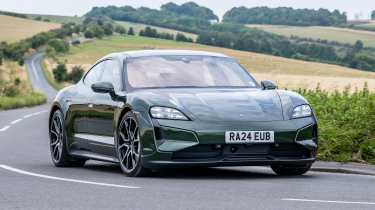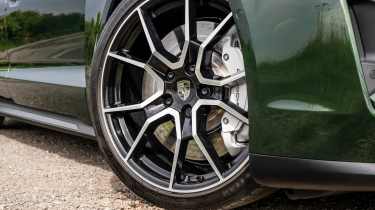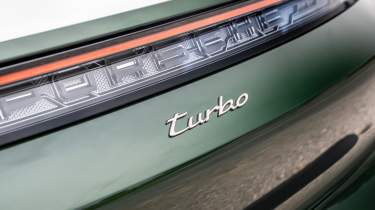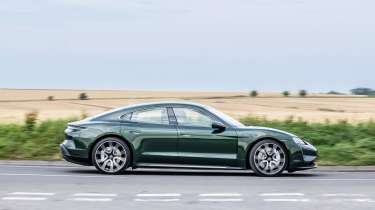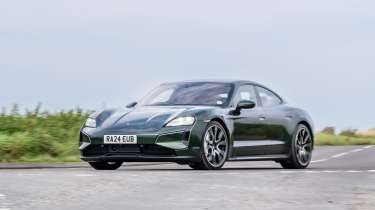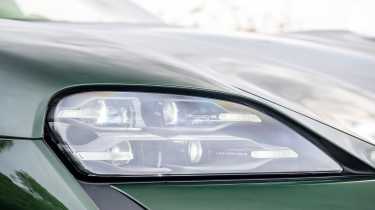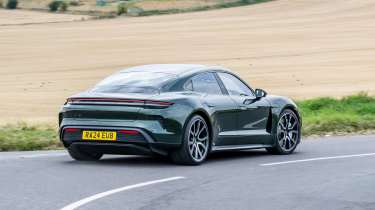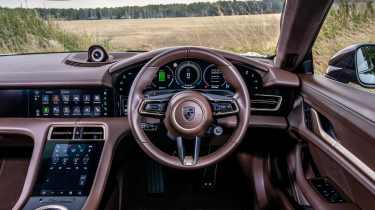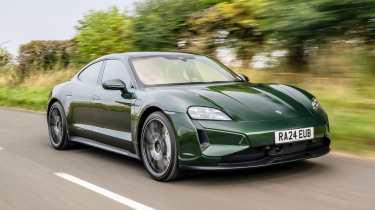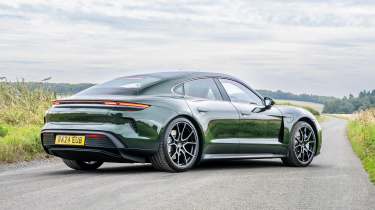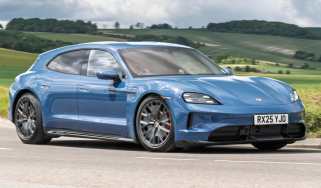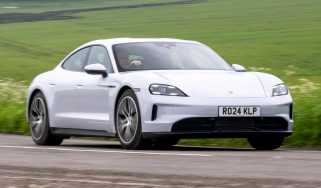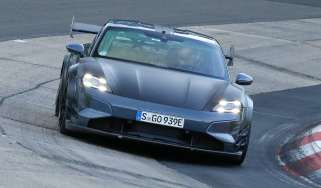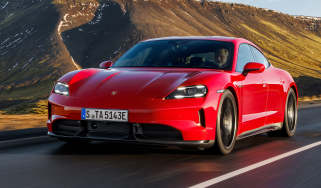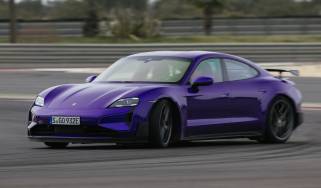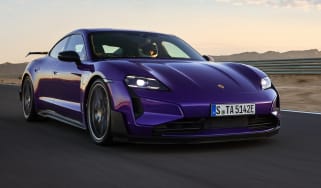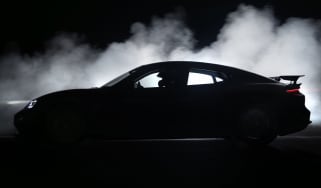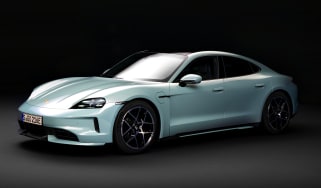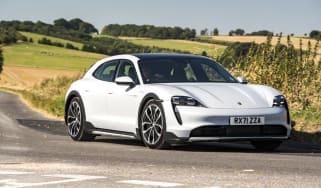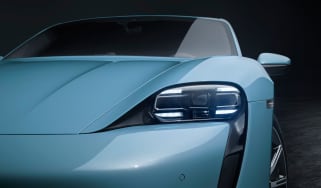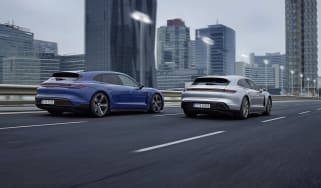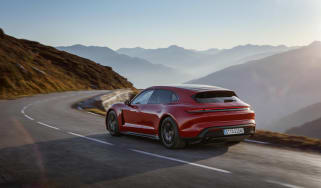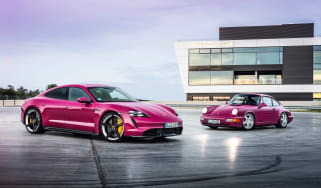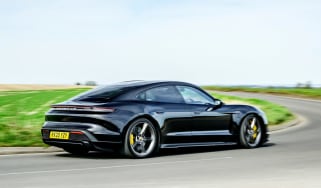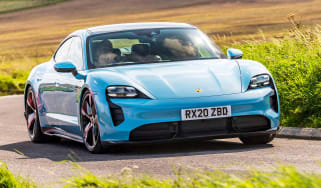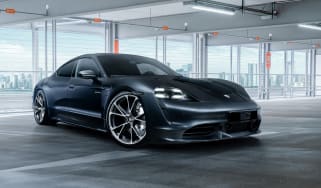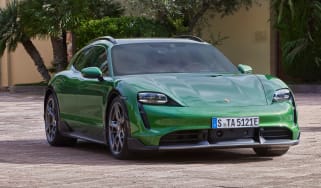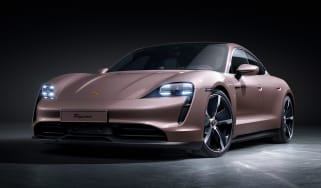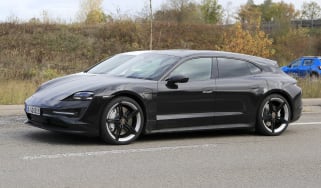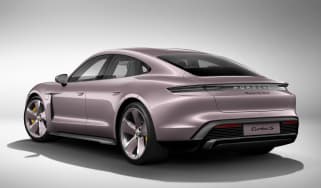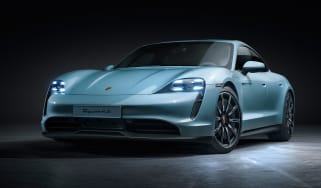Porsche Taycan review – the most complete electric car on sale
The Taycan is one of the most broadly talented EVs you can buy, with class leading performance, range and genuine Porsche DNA in the way it drives
For
- Drives like an electric Porsche should
- Performance ranges from brisk to barmy
- Latest car has a competitive range and charging speeds
Against
- Gets very expensive very quickly, even without options
- Interior is a little touchscreen-heavy
- Limited rear-seat and luggage space next to rivals
evo verdict
The Taycan was a good car at launch in 2019, and it’s a better one today in 2025. The EV world is moving fast but thanks to recent updates, the Taycan isn’t being left behind. It’s still among the most desirable electric cars around, has more performance and range than before, lightning-fast charging capability, and drives… well, like a Porsche. It’s not yet ready to dethrone 911s and Caymans for driving thrills but then it’s not (yet) replacing those cars, and in the meantime is simply another very talented member of the Porsche family. Only limited practicality really hampers its luxury GT credentials.
Background and model range
Such is the rapid pace of EV development that it always feels like there’s something around the corner to set a new benchmark, shifting the goal posts of what an electric car can do. That’s what Porsche has done with the latest, second-generation Taycan. It may look familiar, but it’s taken a huge step forward in every key metric – from performance, range and charging speed to cruising comfort and dynamic ability – to make one of the most desirable EVs on the planet even better. What you’re looking at is the new yardstick for premium electric saloons.
More reviews
Review
Reviews
As one of the best-selling Porsches of recent times, the Taycan appears to have resonated with premium electric car buyers (although it’s a different story on the used market, where it’s been hit with massive depreciation). Its combination of style, polished driving dynamics and build quality – not to mention its ability to time travel when you plant the throttle – make it one of the most rounded EVs you can buy, more so than ever in Gen 2 guise.
The Taycan comes in a variety of forms, including a Sport Turismo estate, a jacked-up, plastic-clad Cross Turismo and a track-honed Turbo GT. There’s a model for almost every use case – if you have the cash, that is. The Taycan doesn’t come cheap, starting at more than £88,000 and stretching all the way to an astonishing £189,200 in its flagship form; big money, but that’s the price you pay for what is an electric saloon at the cutting edge.
Powertrain and technical highlights
- Rear and all-wheel drive models available
- Turbo GT develops well over 1000bhp
- Cross Turismo brings taller suspension and body cladding
All Taycans save for the entry-level model have an electric motor on each axle, with a two-speed gearbox on the rear motor and flat battery pack running the length of the cabin. There are two battery pack sizes, 82kWh and 97kWh, but the packaging is the same for both options. Compared to the original Taycan, the Gen 2’s units are more energy dense, so despite having a larger capacity they’re actually lighter.
The Taycan’s J1 platform packs a raft of sophisticated chassis technology. It supports air suspension (fitted as standard), a torque vectoring rear differential and, new for the Gen 2, optional active suspension – called Active Ride, in Porsche speak. The system uses electrohydraulic pumps to control the support from each damper, with the ability to counteract acceleration, braking and cornering forces to keep the body level. The standard suspension consists of two-chamber air springs with two-valve adaptive dampers (steel springs are no longer an option). Carbon ceramic brakes are available, too, with mammoth 420mm and 410mm discs gripped by ten piston calipers.
The Turbo GT can be ordered with a Weissach Package at no extra cost, which deletes the rear seats and adds carbon buckets up front, as well as carbon B-pillar, door mirror and side skirt trims. This saves a total of 75kg compared to the non-Weissach car, but at 2220kg the Turbo GT is still a heavyweight. It also gets a larger fixed spoiler to boost total downforce to 220kg, as well as Active Ride suspension with a Weissach-specific tune.
At the other end of the spectrum is the Cross Turismo, which sits 20mm higher than standard and comes with a Gravel drive mode to improve traction on loose surfaces. It's only available with four-wheel drive and in 4, 4S, Turbo or Turbo S spec, and weighs around 30kg more than the equivalent saloon. The normal Sport Turismo estate is more road-biased and loses the plastic body cladding and raised ride height.
Power, torque and 0-62mph time
The facelifted mode is more powerful across the board. The Taycan’s peak power output comes under launch control and overboost, which in the base rear-drive version results in 402bhp. This rises to 429bhp if you specify the larger battery option.
The 4S, meanwhile, generates 456bhp from a pair of motors, or 510bhp with the bigger battery. The Turbo is where things get very serious – the 97kWh battery comes as standard, and powers two motors for a combined 872bhp. This increases to 939bhp in the Turbo S, and a Lamborghini Revuelto-beating 1020bhp in the Turbo GT.
The base rear-drive version now takes only 4.8 seconds to get from 0-62mph. The 4S’s extra power and traction cut that down to 3.7sec, and the Turbos move up to supercar – and hypercar – levels of thrust. The “standard” Turbo competes the benchmark in just 2.7sec, the Turbo S in 2.4, and the Weissach-equipped Turbo GT a faintly ridiculous 2.2sec. The Sport Turismo matches the saloon's acceleration times, though Cross Turismo versions are about a tenth slower to 62mph.
The Taycan’s two-speed transmission helps maintain some of that potency at higher speeds, with the base car topping out at 143mph. The 4S, meanwhile, tops out at 155mph, with the Turbo and Turbo S reaching 162mph – not very impressive in the context of their mammoth power outputs, but more than the Mercedes-AMG EQE53 (137mph) and BMW’s i5 M60 (143mph). 180mph for the Turbo GT is a bit more like it (opting for the Weissach Package raises this to 190mph).
Model |
Power |
Torque |
0-62mph |
Top speed |
|---|---|---|---|---|
| Taycan | 429bhp | 310lb ft | 4.8sec | 143mph |
| Taycan GTS | 690bhp | 583lb ft | 3.3sec | 155mph |
| Taycan Turbo GT Weissach | 1020bhp | 915lb ft | 2.2sec | 190mph |
Drive a Taycan Turbo and it’s hard to fathom that there are two even quicker models in the range. The instant, violent performance is borderline unusable unless you’re on a well-sighted road, and it pulls relentlessly up to motorway speeds and beyond. The Taycan’s push-to-pass function unlocks even more performance for ten second bursts – the way it catapults forward from a standstill needs to be felt to be believed.
Find yourself in a Turbo GT, and a launch control start is just about the most violent thing you can experience in a car aside from being rear-ended by a bus. There’s an initial phase where power overwhelms traction, but the Turbo GT still finds phenomenal forward drive from rest and continues to pile on speed well beyond 140mph.
But while the Turbo GT will win any YouTube drag race you throw at it, the 4S is easily fast enough to satisfy your needs as a fast GT car. It's still absurdly quick and flexible but you can find a better flow with it, surging between corners rather than squirting between them in a blur. Unless you’re an insatiable power junky, you really don’t need anything more.
Driver’s note
“Turbo models have truly astonishing performance, but even the single-motor Taycan can out-sprint many sports cars” – Yousuf Ashraf, Staff Writer, drove the Taycan on the road in the UK
Performance, ride and handling
- It might be an EV, but it’s still a Porsche
- Impressive precision and body control for a heavy car
- Active Ride tech gives a luxury-car ride
Rather than the performance, it’s the Taycan’s uncanny precision and accuracy that steals the show. There’s genuine Porsche DNA in everything it does, making it one of the most satisfying EVs to drive of them all.
When fitted with rear-axle steering, its responses are crisp and beautifully measured, allowing you to commit into an apex with one clean sweep of the wheel. The steering is perhaps a touch too heavy when loaded up but this gives a good sense of the forces transmitted through the tyres, and there’s even a hint of granular feel coming through the rim. The brakes don't feel as immediately intuitive, however; the pedal is light and springy initially and firms up once the friction brakes start to blend with the regen, so brushing off speed going into corners requires careful modulation.
Take liberties with the Taycan – all 2170kg of it (in its lightest form) – and it really starts to impress. The facelift introduces Porsche’s Active Ride tech that first appeared on the Panamera, which enables precise control of suspension forces at each corner of the car. It does away with conventional anti-roll bars and uses electro-hydraulic pumps to regulate flow inside the dampers to compensate for pitch and roll.
As a result, the body is extremely well supported and you don’t need to slow down your inputs to allow the weight to settle, which feels a bit alien in such a heavy car. The Taycan doesn’t feel light per se – you’re still conscious of the enormous forces the tyres are dealing with – but Active Ride makes use of all four contact patches by distributing the loads evenly across them, no matter what you throw at it. The (now standard) air suspension setup is impressively poised and flat to begin with, and Active Ride accentuates these qualities.
Does this translate into a more entertaining driving experience? In some ways, yes. It gives you more confidence and encourages you to dig deeper into the Taycan’s abilities. But it does mean that the Taycan can feel slightly clinical in the way it picks apart a road, and it doesn’t offer as much gratification as Hyundai’s Ioniq 5 N with its more interactive driving experience and greater sense of fun.
You need to work the Taycan hard – really hard – for it to feel alive. Reach the limit of the Goodyear Eagle F1s and the chassis feels stable and neutral; you get either a nibble of front-end push or a quick twist of oversteer, and while the Taycan does break away tidily, this feels like a by-product of provocation rather than a natural part of the cornering process. Admittedly, this won’t matter to most owners.
For them, the fact that the Taycan is now better able to lean into its role as a long-distance electric GT will be more valuable. As well as the extra control, the Active Ride system allows the Taycan to flatten large bumps like a luxury saloon, and it wafts along more smoothly – and more quietly – than before.
Where the new suspension isn't as effective is over broken surfaces and high-frequency bumps, which still resonate and vibrate through to the cabin. Switching to the softest damper setting introduces a touch of vertical movement at speed but doesn’t filter out this brittleness, and Sport mode feels like a better compromise.
The Cross Turismo rides 20mm higher than the saloon and Sport Turismo, but the Active Ride tech means that body movements are still tightly controlled in the firmer damper settings. In the softest mode you do get a slight sense of the higher centre of mass, but by-and-large, the saloon's sharpness, consistency of response and precision are all there.
Driver’s note
“No, it isn’t some giant EV drift Porsche that’s determined to silently assassinate tyres. But in this new more potent form, it is now quite quick, unlike the original base Taycan.” – Jethro Bovingdon, Contributing Editor, drove the Taycan RWD on the road in the UK
Efficiency, charging and running costs
- Facelift brought significant range and efficiency improvements
- Up to 421 miles of range
- Some of the fastest charging rates on the market
With a kerb weight of well over two tons and neck-snapping performance, the Taycan will chew through tyres if driven hard, but the brakes should at least hold up well to normal driving (regen is used to slow the car for 90 per cent of the time, rather than the friction brakes).
The extra range of the new Taycan means you’re likely to spend less time topping up at public chargers, potentially making it more cost effective to run (if you have access to home charging, that is). The rear-drive Taycan achieves 367 miles from a full battery, and opting for the Performance Battery Plus boosts this to a very competitive 421 miles
Despite its energy-sapping additional motor, the 4S still achieves nearly 400 miles when equipped with the upgraded battery, with the Turbo and Turbo S getting 391 miles. Predictably, the track-oriented Turbo GT is the least efficient with 344 miles of range, or 345 with the lightweight Weissach Package.
The Gen 2 Taycan is one of the quickest charging electric cars on the market thanks to 320kW capability, and a revised thermal management system that allows faster rates to be maintained in a broader range of conditions. A 10-80 per cent top up takes just 18 minutes.
Interior and technology
- Feels more like a sports car than saloon inside
- Rear seat and boot space a little small
- Turbo GT with Weissach pack feels genuinely special
Nothing much has changed inside the new Taycan, but that's no bad thing. Slide into the driver's seat – made easier with the Active Ride system’s ‘easy entry’ function, which boosts the car up on its springs by 55mm – and the Taycan has a genuine sense of occasion, with a small-diameter steering wheel and the peaks of the wheel arches extending into your view ahead. You don't sit as low as you do in a 911 (thank the floor-mounted batteries for that) but there's definite sports car DNA in the cocooned driving environment, and build quality is excellent throughout.
As is all too common in 2025, the Taycan’s control surfaces are almost entirely digital, but the climate controls are at least a permanent fixture on the lower pressure-based haptic display. Porsche's latest PCM infotainment system is one of the more intuitive on the market, and it gets Apple CarPlay+ functionality as part of the facelift, along with an updated charging planner to plot the most efficient and quickest points to top up during a journey.
The Turbo GT’s interior is altogether more focused if you go for the Weissach Package. Carbon bucket seats hold you securely in place and you’re presented with a suede steering wheel adapted from the GT3 RS, complete with rotary switches for drive modes and PASM settings. There’s also a paddle for activating the overboost function, designed to fall easily at your fingertips when cornering on track.
Seats and boot space
If we have a criticism over the cabin, it's that the Taycan still isn't as roomy as it should be for a five-metre saloon – the rear seats are claustrophobic for adults. The estate versions free up more rear headroom but it's still not a place to stretch out, and there isn't quite as much boot space as you might expect. You get 446 litres compared to 407 in the saloon, where an M3 Touring offers 500 litres. Still, there is at least an 84 litre front boot to stash odds and ends if you need it.
Prices and buying options
Ground floor for the Taycan range currently stands at £88,200, or a grand more if you want the Sport Turismo. Things rise quickly from there: the Black Edition and Taycan 4S are the only others that sneak under six figures, at £95,700 and £96,200 respectively, with the 4S Black Edition coming in at £102,000.
Then it’s another jump to the £118,200 Taycan GTS, £135,200 Turbo, £162,200 Turbo S, and £189,200 Turbo GT, though strangely, adding the Weissach Package doesn’t bump things up further. In the Cross Turismo range meanwhile, the entry-level 4S Cross Turismo starts at £99,200, while the Turbo is £138,200 (two grand more than the equivalent Sport Turismo) and the Turbo S Cross Turismo is £165,200.
If this all sounds a bit much, there is one saving grace: depreciation has been pretty savage on the Taycan so far, so you can probably save five figures on any of the above by opting for a dealer demonstrator or a car that’s only a year or so old.
Equipment and specs
In common with much of the Porsche range, the various Taycans are separated more by their drivetrain than equipment levels, bar one or two details here and there – a special wheel or colour option, some subtle exterior detailing, that kind of thing. Expect leather trim across the range (though a leather-free Race-Tex option is also available), a three-screen setup in most models (driver display, centre touchscreen, lower air conditioning touch display), electric seat adjustment, and more.
The standard wheel size is 19 inches even on the standard Taycan, though that steps up to 21 inches by default from the Black Edition. The most significant visual changes come with the Turbo GT and its aero flicks and forged 21-inch wheels, and inside with its fixed-back bucket seats.
Rivals
You need only look across the Porsche showroom to spot one of the Taycan’s potential rivals – the Panamera. Porsche’s combustion-powered saloon starts and ends at a similar price point to the Taycan (from £89,400 for the standard Panamera to £175,100 for the 771bhp Panamera Turbo S E-Hybrid), has a similar 911-inspired fastback roofline, and is similarly good to drive, powertrain preferences aside. If you’re not convinced by electric power, the Panamera still ticks the sports and luxury boxes very well indeed.
Look elsewhere and the choices quickly get overwhelming. The Mercedes EQE and BMW i5 could both be considered Taycan rivals, though both lean more towards space and luxury than the Porsche’s sports-car-adjacent appeal. Audi’s e-tron GT is another, and is largely similar to the Taycan under the skin – in this case, Audi has toned down the sporting feel ever so slightly in favour of touring comfort.
Neither Tesla (with the Model S) nor Lucid (with the 1200bhp+ Air Sapphire) sell their Taycan rivals in the UK, but one UK brand (by way of China) does have a car that takes aim directly at the Taycan: the Lotus Emeya. With a starting price of £89,500 it’s in the same ballpark as the basic Taycan and has the performance and handling to match the Porsche. Like the Taycan, it’s also probably best sampled at the lower end of the range, where performance is still plentiful, pricing is lower, and range is higher.
Another we’re chucking into the ring, purely for fun, is the otherwise very different Hyundai Ioniq 5 N. It doesn’t have the Porsche’s image and its form factor is more Qashqai than 911, but Hyundai’s engineers have done a stellar job making an EV that isn’t just fast, but great fun to drive too, and a whole lot cheaper.
Model |
evo rating |
Price |
Kerb weight |
Power |
0-62mph |
|---|---|---|---|---|---|
| Taycan 4S | 4.5 | £96,200 | 2250kg | 590bhp | 3.7sec |
| BMW i5 M60 xDrive | 4.0 | £97,845 | 2370kg | 593bhp | 3.8sec |
| Lotus Emeya 600GT SE | 4.0 | £94,990 | 2555kg | 595bhp | 4.2sec |
| Hyundai Ioniq 5 N | 4.5 | £65,100 | 2235kg | 641bhp | 3.4sec |

